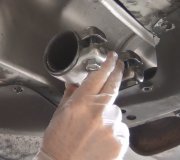There is a company that advertises on this site about some kind of "mechanic in a can" fix for head gaskets. Normally I don't put much faith in any types of additives that claim to repair mechanical problems, especially permanently, but I never looked into this product or used it. Apparently they must be having some success or they wouldn't be selling it.
I assume you have the 3.0L engine since that's the only V-6 I ever saw in your car model. I have the same engine in my rusty trusty '88 Grand Caravan with 378,000 miles. Leaking head gaskets can happen to any engine, especially when they have cast iron engine blocks and lighter aluminum cylinder heads that heat up and expand at different rates. The head gaskets have an unusually difficult job of sealing while parts are trying to shear it apart.
Besides the gaskets, the cylinder heads can warp too. It used to be common to send them to a machine shop to be "surfaced" which is to cut them flat on a special machine, kind of like sanding them. Your heads, like most front wheel drive cylinder heads can't be machined if they are warped. They must be heated and straightened because there is a rotating camshaft on top that would bind. When the head is straightened, it brings those shaft's mounting surfaces in line too. Fortunately, it is common on your engine to replace just the head gaskets and to find no other repairs to the head are necessary, at least as far as straightness is concerned.
Your mechanic should check the exhaust valve guides to see if they have little wire retainer rings under the seals. I think by '94 that modification was done already. My engine needed to have that done at 68,000 miles, while still under warranty. Without those rings, the guides could slip out of position and allow engine oil to enter the engine and be burned. That resulted in tons of blue exhaust smoke, but the engine ran fine. You have white smoke, so valve guides aren't the problem. The valve guide repair also involves removing the cylinder heads, so you would still get new head gaskets.
Head gaskets can also leak more when the engine cools down and parts change shape. Coolant would leak into the cylinder until the pressure was gone, which can occur rather quickly. The smoke would only occur until the coolant was burned out of the engine. After that, the leak might be so slow, you just don't see the smoke.
Caradiodoc
Tuesday, March 23rd, 2010 AT 6:34 PM


